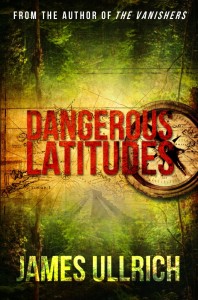Dangerous Latitudes
Q&A with author James Ullrich on his new novel, Dangerous Latitudes
Q: Tell us a little more about your main character in “Dangerous Latitudes”, travel writer Matthew Hunt.
A: As you said, he’s a travel writer. He’s a loner, kind of laconic, and comes off as kind of gruff. But he’s a decent guy who strives to so the right thing, in the big picture. He’s got a good heart. That’s not to say he’s perfect.
Since he’s always traveling and observing and immersing himself in far flung bits of the world, Hunt’s not exactly “normal”. He’s is a bit of step with the norms and expectations of the regular world. He’s like a man with a fork in a world of soup. I actually have one of the characters in Dangerous Latitudes call him that. But that turns out to be a virtue of his.
He’s profoundly curious, and that drives him. He’s driven to learn and explore, and bring that little slice of the world back to his readers. He sees it as a moral issue. And so sometimes—almost always, actually—gets him into more than he bargained for. His fortitude in the face of difficult circumstances and his desire to solve the mystery really drives the stories.
The series takes place in the late 60’s, for a very strategic reason: I didn’t want to give him or other characters an easy way out of trouble. For instance, if someone’s lost in the jungle or the desert in this decade they can use an app on their smart phone or i phone and find out exactly where they are and contact help, or do a bunch of other things. I didn’t want that “easy out”, neither for myself as a writer nor for my characters. Hunt and anyone else on the stories will have maps, compasses, and their own wits. I want to keep it old school.
Q: How much of this story is based on fact?
A: Quite a lot, actually. Like most great stories, it’s got some roots in historical reality. There have been theories and whispers about a civilization in the Amazon, lost to time and history, circulating for centuries. The Conquistadores wrote about it, as mentioned in the novel. Victorian explorer Percy Fawcett famously went missing while looking for it. That factors into the plot too. I did a ton of research in writing it; I owe a huge debt of gratitude to Professor Anna Roosevelt, whom I interviewed as part of my research. Dr. Roosevelt is the great-great granddaughter of President Theodore Roosevelt, and is one of the world’s leading experts on ancient South American archeology. She was very helpful in explaining some of the most recent evidence found in the region, much if it that supporting the Conquistadors’ reports.
Q: Will this be the beginning of a series?
A: Many people have asked me about that, and the answer is…Yes!
* * *
Reality and Fiction: Fawcett, the Conquistadors, and “Z”
The events and characters in this book are fictional, with the notable exception of Col. Percy Fawcett and his doomed quest for “Z”.
One of the last true swashbuckling explorers of the Victorian era, Fawcett (b. 1867) was a member of the Royal Geographic Society and led several famous expeditions in Brazil, Peru, and Bolivia. In 1906 the President of the Royal Geographic Society called a meeting with Fawcett and proposed a dangerous but thrilling project. “Look at this area!” he exclaimed, showing a largely empty map of the Amazon to Fawcett. “It’s full of blank spaces because so little is known of it.”
He chose his mark well. Fawcett took the job.
The more he learned of the region and its mythology, the more an idea began to grow in his mind. He became obsessed with the idea of a lost civilization whose capital city, he believed, lie shrouded in overgrowth waiting to be discovered somewhere in the Amazon’s Mato Grosso region. He called the city “Z”, and took seriously some of the Conquistador’s wild claims about cities hidden in the mist. Most historians and experts on South America believed he was deluded.
He launched his final expedition in 1925 from Cuiaba and, as mentioned in the novel, took only his son Jack and Jack’s best friend Raleigh Rimmell. His final known letter, written to his wife from Dead Horse Camp, expressed a belief that they were closing in on the lost city and would soon make history by proving the legends correct. They were never heard from again. His son Brian, who was left out of the expedition, never gave up hope that the three would emerge from Brazil’s forests alive.
As in the novel, it is known that he purposely misled others by giving false coordinates in order to ensure they did not beat him to “Z.” Some of his letters and artifacts can still be seen in the archives of the Royal Geographic Society in London.
There have been many theories as to the ultimate fate of the Fawcett and his two assistants. Some are wild—aliens, time travel—but most are more predictable; poisonous snakes, drowning, angry natives, and starvation in the ‘vast green hell” are the most likely.
Their bodies have never been found. Nor has the lost city of “Z”.
***
I owe a debt of gratitude to Professor Anna Roosevelt, whom I interviewed for this book. Dr. Roosevelt is one of the world’s leading experts on ancient South American archeology. She kindly took time from her teaching duties at University of Illinois to give me valuable insight into the latest findings in the Amazonian region. Her research has yielded evidence indicating the existence of sophisticated human civilization in the area many centuries before the long-assumed time frame.
* * *
All of the locations in this book (except, of course, for the Lost City itself) exist as portrayed.

